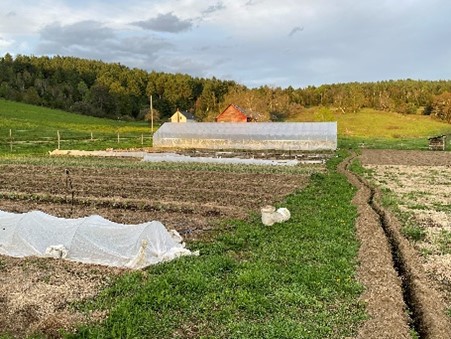By Noah Gilbert-Fuller, VT Agency of Agriculture, Food & Markets
With Vermont returning to lush, green colors for this summer season, Vermont’s farmers are working hard tending to crops, raising livestock and stewarding the land. This hard work also comes with a need to adapt to many changing conditions. Not only do farmers have to deal with pests and the weather, they also have to get their produce to market where consumers can buy it. In the face of all these sources of uncertainty, business planning can elevate a farm’s ability to market themselves, generate income, manage risk, and meet their goals for their farm’s future.
Glinnis Hill Farm is a diversified vegetable farm run by Gus Glinnis and Mollie Podmore on the site of a historic dairy barn in Berlin, VT. The start of the journey in 2022 began with a goal: to revive and conserve the farm while contributing to local food and economic resilience. To do that, the farm realized they needed to plan out how they would achieve productivity and viability.
Reaching out to the Intervale Center and their business planners, Gus and Mollie were able to develop a Business Plan that laid out their objectives for growth over a 10-year period. They then could send this document to organizations that help farmers finance, lease, conserve, and manage land to gain their support as they started operations. For example, before they started farming, Glinnis Hill Farm was asked by their town Zoning Administrator to receive a Farm Determination from the Vermont Agency of Agriculture, Food and Markets to meet local land use requirements. They were able to use their Business Plan as an outline of how they would manage their property and meet the criteria of a Small Farm Operation.
Though unexpected challenges may arise and cause farmers to adapt to market conditions in real time, a thorough Business Plan can help a farm navigate through these challenges while working towards their goals. In addition, business plans allow prospective farmers to show how they plan to meet the conditions in local town bylaws around agricultural land use. This often makes it easier to start farming, especially if the farm business needs to construct farm structures.
Section 3.1(g) of the Required Agricultural Practices (RAPs) states that a farm may submit a “…prospective business or farm management plan, approved by the Secretary, describing how the farm will meet the threshold requirements of this section” to meet the definition of a Small Farm Operation regulated under the RAPs. Even if a farm does not meet those criteria right at the outset of their business, a prospective farm can describe how their operation will meet RAP criteria, such as farming 4.0 contiguous acres, or making $2,000 or more in income from the sale of agricultural products, by designing a farm management plan and cash flow worksheet.
Business Plan materials are evaluated by the Agency of Agriculture, Food and Markets.
Since last year, Glinnis Hill Farm has started operations with a Market Style CSA, which provides members farm credit to their dollar which they spend on food items they may choose. One of their proudest achievements so far is their “Solidarity Shares” program which offers free or reduced cost shares to underserved individuals. This is done through a sliding scale pricing program, where customers are presented with an average rate and may pay above or under the average rate depending on their needs. This strong vision is supported in the farm’s Business Plan with activities such as on-farm concerts that subsidize the Solidarity Shares and bring in a wide customer base who feel invested in making a more equitable food system.
The Vermont Agency of Agriculture, Food and Markets Agricultural Development Division hosts a webpage dedicated to New and Beginning Farmer Resources, with a section on Business Planning. You can find the webpage at this web address: https://agriculture.vermont.gov/development/new-farmer-resources#BP&A.
For Farm Determination Business Plan Guidelines, visit https://agriculture.vermont.gov/document/business-plan-guidelines-farmers.
For more information on Farm Determinations and the Required Agricultural Practices, visit https://agriculture.vermont.gov/water-quality/regulations/farm-definitions-and-determinations or contact Noah Gilbert-Fuller at Noah.Gilbert-Fuller@vermont.gov or (802) 505-3407.

Gus Griffin and Mollie Podmore, pictured with plant starts at the beginning of the season.

Glinnis Hill Farm: The view of the beds and the buildings at the historic Glinnis Hill Farm.

